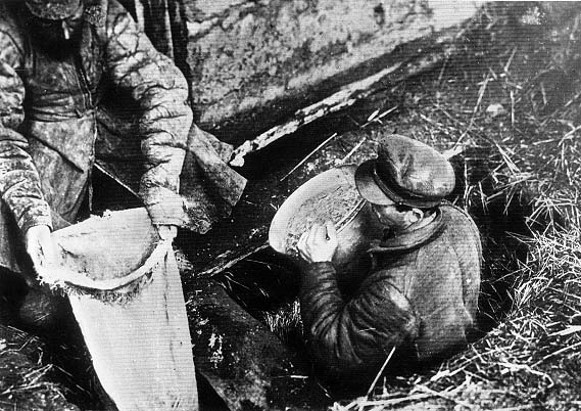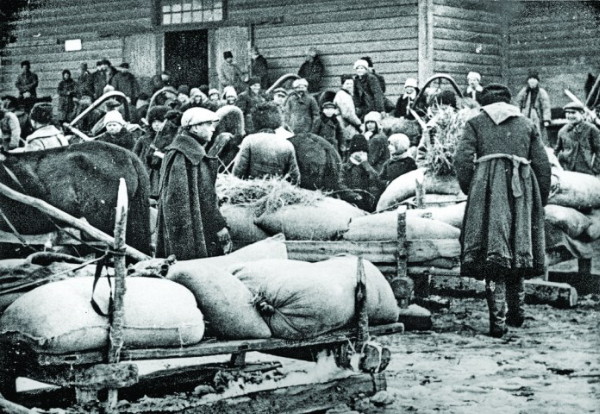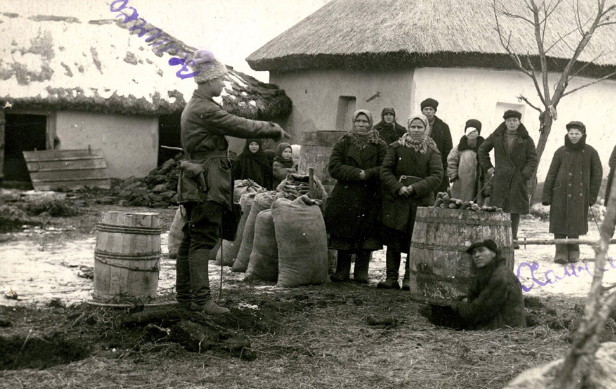Grain procurement
Grain procurement. The means by which the state obtains large grain reserves to feed the armed forces, the civil service, and the industrial work force, to use as export, and to be fully able to satisfy the consumption needs of the population. In contrast to purchase on the open market, procurement is compulsory in nature and involves a fixed, stable, and, as a rule, low price.
Grain procurement was introduced by the tsarist regime during the First World War. The Ministry of Agriculture and a special board of food supply procured grain at fixed prices that were, at first, higher than the market prices. Rampant inflation and speculation caused an increase in the market prices, however, and farmers became reluctant to sell grain to the state. The authorities then resorted to requisitioning, which aroused deep discontent among the peasantry. In 1914–15, the state procured 41.7 percent of the grain available on the open market; in 1915–16, 51.3 percent; and in 1916–17, 67.9 percent. Even though it possessed two-thirds of all marketable grain on the eve of the Revolution of 1917, the state was unable to supply the population adequately.
During the period of War Communism the Bolshevik state applied the policy of forced grain expropriation on a massive scale. A surplus appropriation system (prodrazverstka) was introduced, whereby each peasant household was ordered to turn over its food surplus to the state at a fixed price. As a result of rampant inflation and the lack of manufactured market goods, however, money lost its value, and state payments for grain deliveries became worthless; when they were finally abolished the farmers did not even notice it. In March 1919 the prodrazverstka (Ukrainian: prodrozkladka) was extended to Ukraine. It was implemented with the help of committees of poor peasants, armed workers' detachments, and the Cheka, which seized grain and punished the ‘hoarders.’ The peasants, left with almost no food, naturally resisted, and armed struggle ensued between the Soviet regime and the peasants and among the peasants themselves. Peasant partisans (see Partisan movement in Ukraine, 1918–22) resisted and attacked the Reds and the Whites throughout Ukraine, and until the Red Army emerged victorious, the Ukrainian peasantry combated the prodrazverstka via armed struggle, the black market, reduced sowings, and concealment.
In 1920–1, when the main anti-Bolshevik forces had been defeated, Ukrainian grain deliveries to the Soviet state amounted to 2.6 million t out of a gross harvest of about 8.6 million t. This expropriation, combined with drought and reduced sowings, led to the Famine of 1921–3 and millions of deaths in the five southern gubernias of Ukraine. Faced with declining productivity and mass unrest, the authorities decided to replace the prodrazverstka with a less stringent tax in kind. This shift marked the beginning of the New Economic Policy and the restoration of the private sector in small-scale trade and industry. In 1921–2 grain deliveries to the state amounted to 1.9 million t, parts of which were used to create local reserves. In 1924 compulsory deliveries of food supplies were abandoned and were replaced by a monetary tax.
The period of freedom from compulsory deliveries of grain and other farm products did not last long. In January 1928 they were reinstituted. Peasants were forced to sell grain at a fixed low price; in Ukraine in 1927–8 they were paid 7 rubles per 100 kg of wheat, and in 1928–9, 8.30 rubles (the free market price was 11 and 26 rubles respectively). Peasants who refused to surrender their grain to the state were charged under article 127 of the Criminal Code of the Ukrainian SSR with speculation and concealment of goods, which were punishable by one year of imprisonment and the confiscation of property. A quarter of the grain obtained in this way was distributed free to the rural poor to gain their support for collectivization and for punitive measures against the peasants, who were held responsible for the shortages (see Kulak).
The peasants responded to the reintroduction of compulsory deliveries by decreasing productivity. This, in turn, provoked the state to implement new, drastic measures, such as grain seizures, arrests, and confiscation. At the 11th Congress of the CP(B)U in 1930, it was stated that in only 22 of Ukraine's 41 okruhas, 33,000 peasant households were prosecuted and their property confiscated. In order to give the compulsory deliveries a legalistic semblance, seeded land was declared to be under contract.
In contrast to common practice, however, the contracts were not entered into voluntarily by the peasantry and the state did not assume any obligations, such as supplying seed, equipment, or goods. Directives for the procurement plan came from the center, were confirmed at a general meeting of the poor peasants or of all the inhabitants of a village, and then were vigorously implemented by local officials, who were given the authority to impose fines up to five times the imposed quota for late or incomplete grain delivery and even to confiscate the property of unco-operative peasants. Deliveries were officially viewed as the ‘natural’ fulfillment of the agricultural tax and of other obligations, which were numerous by the late 1920s—self-assessment, compulsory insurance, obligatory loans for the consolidation of peasant holdings, and obligatory industrialization loans—and often exceeded a peasant family's total income.
After collectivization began, extremely high delivery quotas were levied to compensate for earlier shortfalls. When the kulaks and other peasants refused or were unable to meet them, practically all their grain stocks were confiscated. After the ‘liquidation of the kulaks as a class,’ the collective farms and state farms assumed the burden of grain deliveries. Peasant opposition to collectivization caused agricultural production to decline dramatically, yet the state continued to demand delivery of the same and even greater grain quotas (see table).
Before collectivization the peasants had surrendered less than a fifth of their harvest to the state. In 1929–30 the state increased the share to 30 percent for the USSR as a whole and 40 percent for Ukraine. In fact, the state received an even higher percentage because harvest yields were distorted. In January 1933, CP(B)U General Secretary Stanislav Kosior referred to the previously standard methods of estimating harvests as ‘kulak arithmetic’ and urged party workers to ignore them. The Central Statistical Administration had been abolished, many noted statisticians and other critics had been arrested, and officials were thus able to demand excessive procurements using an artificial device called ‘biological yield.’ For example, the real USSR harvest in 1933 was 68.4 million t, whereas the biological harvest was estimated at 89.8 million t. Consequently delivery plans were increased to impossible levels.
This state of affairs led to the terrible, man-made Famine-Genocide of 1932–3. Special detachments of urban activists searched the homes of collective and independent farmers and seized all the grain they could find to fulfill the delivery quota. Peasants were forbidden to save grain for seed, feed, or even human comsumption; all of it was removed. Even so, the excessive delivery plans imposed in Ukraine could not be fulfilled. As punishment, individual villages, rural soviets, and even raions were blacklisted and deprived of commodities, all institutions in them were closed down, trade was prohibited, and the population's livestock was confiscated for next year's meat delivery. All these measures resulted in several million deaths from starvation and related diseases in Ukraine. At the time, the absolute priority of state procurements was enacted. In mid-1933 the state issued a compulsory procurement decree. According to it, collective farms in Ukraine had to deliver 3,100 kg of grain from every ha of seeded land that was not worked by a machine-tractor station (MTS), and 2,500 kg from every ha that was worked by an MTS. The state received even more grain—approximately 20 percent of the harvest (150–200 kg/ha) paid by each collective farm to the MTS for its services. The delivery quotas of independent and collective farmers with private plots were even higher. In general, quotas were not based on the harvest, and non-fulfillment resulted in fines, expropriation, imprisonment, and deportation.
The 1933 decree guaranteed that collective farmers had the right to freely dispose of all grain left over after the collective farms had fulfilled their obligations to the state and had made full provision for seed, reserve, and feed funds. The quantity of grain taken by the state was so great, however, that in most cases, after fulfilling their deliveries and stocking their funds, the collective farms had no surplus. The payments in kind to the machine-tractor stations changed several times in subsequent years. In 1937–9 the rate was 45–50 percent of all grain collected and depended on the harvest and the type of work done; in 1954–7 the rate was fixed at 220 kg per ha of arable (instead of sowed) land. Besides procuring most of its grain by compulsory means, the state also purchased a smaller amount (10–15 percent) from the collective farmers at above-quota prices. In 1939, for example, the procurement price paid for wheat was 9.42 rubles per 100 kg, while the above-quota price was 23.97 rubles per 100 kg. Procurement prices barely changed for over 20 years and became divorced completely from real costs and values. Thus, in 1953 the state paid 10 kopecks for one kg of wheat, whereas it sold one kg of flour for 5 rubles. This disparity discouraged incentive and productivity. From time to time enormous procurements would leave the rural population without grain and famine would again flare up, as it did in 1946 in most of the oblasts of Ukraine and Moldavia (see Famine of 1946–7).
When the Germans occupied Ukraine during the Second World War they left largely intact the entire Soviet collective- and state-farm system. In some regions of Ukraine, grain quotas imposed by the Nazis on collective farms were double the 1941 Soviet norm. Between 1941 and 1944 over 80 percent of the six million tons of grain requisitioned by the Reich from the occupied territories of the USSR came from Ukraine. After Joseph Stalin's death the Soviet procurement system began to change. The September 1953 CC CPSU plenum raised the purchase prices of grain significantly and reduced the quotas of compulsory deliveries. Even more important changes took place in 1958 and 1965: the purchase prices were raised by a large factor, a bonus of 50 percent for deliveries above the quota was established, payment in kind for MTS services was abolished, and the machine-tractor stations were finally disbanded. Purchase prices began varying regionally across the USSR. In 1968, for example, the average price of wheat was 68 rubles per t; in southern Ukraine it was 65 rubles on collective farms and 28.5 rubles on state farms; in the Soviet Far East it was 121 rubles. These changes resulted in increased productivity, larger harvests, and larger purchases in the 1960s. At the same time Ukraine's contribution to the general procurement plan was lowered, and the percentage of the grain taken from Ukrainian peasants fell (see table).
In the 1970s and 1980s, however, the situation again became more complex. At first gross harvests ceased to increase; then they began to decline. As a result, official data about harvests was not published. In order to remedy this state of affairs, the authorities conducted various experiments in the countryside. But compulsory deliveries of grain and other farm products to the state were not abolished. (See also Agricultural procurement.)
BIBLIOGRAPHY
Materialy po istorii sel’skogo khoziaistva i krest’ianstva SSSR, 3 (Moscow 1959)
Kononenko, K. Ukraïna i Rossiia: Sotsiial’no-ekonomichni pidstavy ukraïns’koï natsional’noï ideï, 1917–1960 (Munich 1965)
Moshkov, Iu. Zernovaia problema v gody sploshnoi kollektivizatsii (Moscow 1966)
Tseny i tarify (Moscow 1969)
Volodymyr Kubijovyč, Sergei Maksudov
[This article originally appeared in the Encyclopedia of Ukraine, vol. 2 (1988).]



